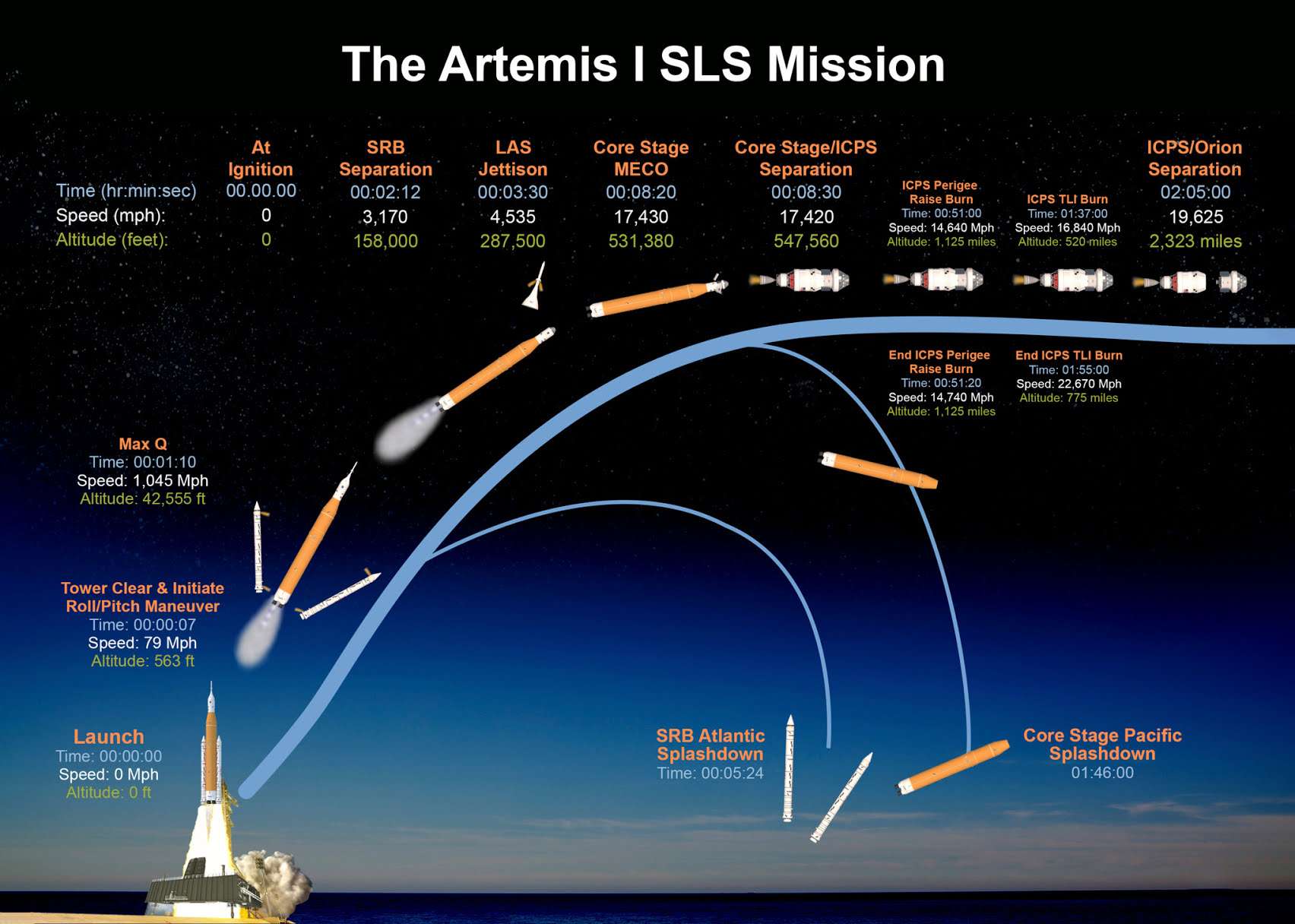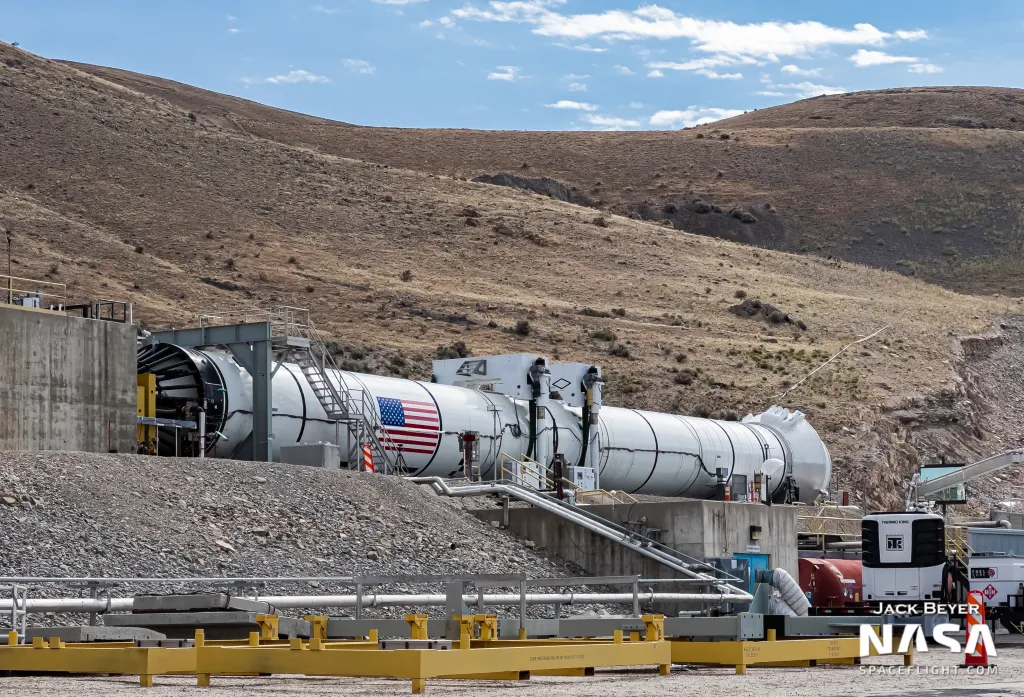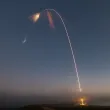Featured image credit: NASA
Lift Off Time | November 16, 2022 – 06:47:44 UTC | 01:47:44 EST |
|---|---|
Splashdown Time (Estimated) | December 11, 2022 – 17:40 UTC | 09:40 PST (Mission Duration: 25 days, 10 hours, and 53 minutes) |
Mission Name | Artemis I, the first launch of the Space Launch System |
Launch Provider | NASA – Boeing, Aerojet Rocketdyne, Northrop Grumman, and the United Launch Alliance (ULA) |
Customer | NASA |
Rocket | Space Launch System (SLS) Block 1 with the Orion spacecraft |
Launch and Splashdown Location | Launch Complex 39B, Kennedy Space Center, Florida, USA Splashdown: Pacific Ocean, off San Diego; will be recovered by USS Portland |
Payload mass | Launch: ~26,520 kg (58,500 lb) to lunar orbit, plus small sats Landing: ~8,200 kg (18,200 lb) |
Where did the spacecraft go? | Distant Retrograde Lunar Orbit |
Did they attempt to recover the first stage? | No; first-stage recovery is not a capability of the Space Launch System |
Where did the first stage land? | The SRBs splashed down in the Atlantic Ocean and the core stage splashed down in the Pacific Ocean |
Did they attempt to recover the fairings? | No, the launch abort system (LAS) and fairing are not recovered |
Were these fairings new? | Yes |
This was the: | – 1st launch of the Space Launch System – 2nd orbital launch of the Orion spacecraft – 3rd overall flight of the Orion spacecraft – 161st orbital launch attempt of 2022 – Furthest a spacecraft for crew will have ever been from the Earth – Most powerful rocket in the world at the time of launch (depending on how you count Starship) |
Orion Stats: | – Traveled over 2,000,000 km (1,300,000 miles) – Will reenter at 40,000 km/h (24,500 mph) – Reentry temperatures will reach 3,000 K – Furthest distance from Earth: 480,494 km (298,545 miles) (the furthest a crew-rated spacecraft has been from Earth) – Closest approach to the moon: 128 km (80 miles) |
Where to watch | Launch: Official Launch Replay; Everyday Astronaut Replay Landing/Splashdown: Tim Dodd, the Everyday Astronaut, will be streaming at T-1 hour; come ask questions and join the conversation live! |
How Did It All Go?
NASA successfully launched the Orion spacecraft to a distant retrograde lunar orbit atop the Space Launch System (SLS) for its maiden launch. Launched from Launch Complex 39B, at the Kennedy Space Center, in Florida. The Artemis I mission will certify both Orion and the SLS Block 1 rocket for crewed spaceflight; its next mission — aptly named Artemis II — will be crewed, and bring a yet-to-be-announced crew to lunar orbit (but will not land on the lunar surface).
This orbit marked the furthest a spacecraft certified for crew will have been from Earth at over 450,000 km. Additionally, this mission marked the longest a spacecraft will have free-flown (not docked to another spacecraft or space station), with a planned mission duration of 25 days (previously 42 days). At the time of launch, the SLS Block 1 rocket became the most powerful rocket in the world (although, SpaceX’s Starship rocket will take this record shortly).
In addition to the Orion spacecraft, SLS launched 10 6U smallsats as part of the low-cost CubeSat mission. They are mounted on the Stage Adapter.
By all accounts, so far this mission has gone phenomenally well. The SLS center core with its four RS-25 engines performed “perfectly,” along with the two Solid Rocket Boosters, which performed “extremely well.”

Artemis I Major Milestones and Timeline
| Flight Day 1 | Launch, translunar injection |
| Flight Day 2-5 | Outbound Transit |
| Flight Day 6-9 | Transit to Distant Retrograde Orbit (DRO) around moon; on flight day 6, Orion passed 130 km from the lunar surface |
| Flight Day 10-15 | In DRO; on flight day 11, Orion passed the Apollo 13 record of 400,171 km away from Earth |
| Flight Day 16-19 | Exit DRO |
| Flight Day 20-26 | Return Transit; on flight day 20, Orion passed 128 km from the lunar surface |
Reentry Timeline
| Time (UTC)* | Reentry Event |
| 17:00:10 | Crew Module/Service Module Separation |
| 17:20:14 | Crew Module Entry Interface |
| 17:35:28 | Altitude ~12 km |
| 17:36:02 | Forward Bay Cover (FBC) Chute Deploy |
| 17:36:04 | FBC Jettison |
| 17:36:06 | Drogue Chute Deploy |
| 17:37:26 | Main Chute Deploy and Drouge Chute Jettison |
| 17:39:41 | Splashdown! Time for humans to return to the moon |
Artemis I Mission
Artemis I (originally known as Exploration Mission 1 (EM-1)) was announced in 2012 following the cancelation of the Constellation program. With it, NASA announced that the SLS rocket would bring the Orion spacecraft and European Service Module, which is based on the Automated Transfer Vehicle (an ISS resupply spacecraft), to lunar orbit. With the goal of bringing humans back to the Moon safely and sustainably (unlike Apollo), the Artemis program is very different from the Apollo program.
To start, the most notable difference is that the Artemis program will require several launches to return humans to the lunar surface, whereas Apollo only required a single launch. This allows for the program to bring significantly more to the surface, with the Starship Human Landing System (HLS) being able to deliver up to 150 metric tonnes to the surface–an unprecedented amount of cargo.
Countdown Timeline
The Space Launch System utilizes two different countdowns: “L Minus” indicates how far away liftoff is. More confusingly, “T minus” refers to a sequence of events that are built into the launch countdown. This includes holds, which are built into the countdown to allow the launch team to target a precise launch window, and provide a time cushion for certain tasks to be completed. During SLS’ countdown, the T- time intentionally stops.
Following the Artemis I launch scrubs in the August and September window, the timeline was updated to allow more time to deal with any difficulties in loading the LH2 into the core stage fuel tank.
Prior to the ten-minute terminal count, the countdown sequence of events is as follows:
| Time Before Launch (h:m) | Event |
| L-47:40 | The launch team arrives on their stations and the countdown begins |
| L-47:00 | Fill the water tank for the sound suppression system |
| L-47:00 | Liquid Oxygen (LO2)/Liquid Hydrogen (LH2) System Preparations for Vehicle Loading |
| L-43:00 | The Orion spacecraft is powered up if not already powered at Call to Stations |
| L-39:30 | The interim cryogenic propulsion stage is powered up |
| L-38:00 | The core stage is powered up |
| L-37:20 | Final preparations of the four RS-25 engines |
| L-32:00 | Core stage composite overwrapped pressure vessel, Pressurization to Flight Pressure |
| L-31:00 | Charge Orion Flight Batteries to 100% |
| L-28:00 | Charge core stage Flight Batteries |
| L-19:00 | The ICPS (Interim Cryogenic Propulsion Stage) is powered-up for launch |
| L-13:00 | All non-essential personnel leave Launch Complex 39B |
| L-11:15 | Ground Launch Sequencer Activation |
| L-11:45 | Air-to-gaseous nitrogen Changeover for vehicle cavity inerting |
| L-10:40 | 3.5 hour built-in countdown hold begins |
| L-10:40 | Launch team conducts a weather and tanking briefing |
| L-9:40 | Launch team decides if they are “go” or “no-go” to begin tanking the rocket |
| L-9:15 | Core Stage LO2 transfer line chilldown |
| L-9:15 | Core Stage LH2 chilldown |
| L-9:00 | Core stage LO2 main propulsion system chilldown |
| L-8:45 | Core Stage LH2 slow fill start |
| L-8:20 | Core stage LO2 slow fill |
| L-8:05 | Core Stage LO2 fast fill |
| L-7:50 | Core Stage LH2 fast fill |
| L-7:40 | Engine bleed kick start |
| L-6:10 | Core Stage LH2 topping |
| L-6:05 | Core Stage LH2 replenish |
| L-5:20 | ICPS LH2 ground support equipment and tank chilldown |
| L-5:20 | Core Stage LO2 replenish |
| L-5:15 | Core stage LO2 topping |
| L-5:05 | ICPS L02 MPS (Main Propulsion System) chilldown |
| L-5:05 | ICPS LH2 fast fill start |
| L-4:20 | Orion communications system activated |
| L-4:45 | ICPS L02 fast fill |
| L-4:10 | ICPS LO2 validation and leak test |
| L-4:00 | ICPS LH2 validation and leak test |
| L-3:40 | ICPS LH2 tank topping start |
| L-3:25 | ICPS LH2 replenish |
| L-3:40 | ICPS LO2 toppingICPS/Space Launch System telemetry data verified with Mission Control and SLS Engineering Support Center |
| L-3:20 | ICPS LO2 replenish |
| L-2:55 | ICPS/Space Launch System telemetry data verified with Mission Control and SLS Engineering Support Center |
| L-0:50 | Final NASA Test Director briefing is held |
| L-0:40 | Built in 30-minute countdown hold begins |
| L-0:15 | The launch director polls the team to ensure they are “go” for launch |
Terminal Count
| Terminal count timeline (m s) | Event |
| T-10:00 | Ground Launch Sequencer initiates terminal count |
| T-6:00 | GLS go for core stage tank pressurization |
| T-6:00 | Orion ascent pyros are armed |
| T-6:00 | Orion set to internal power |
| T-5:57 | Core Stage LH2 terminate replenish |
| T-5:00 | GLS is go for flight termination system arm |
| T-4:40 | GLS is go for LH2 high flow bleed check |
| T-4 m | GLS is go for core stage auxiliary power unit start |
| T-4 m | Core Stage APU (auxiliary power unit)starts |
| T-4 m | Core stage L02 terminate replenish |
| T-3:30 | ICPS LO2 terminate replenish |
| T-3:10 | GLS is go for purge sequence 4 |
| T-1:56 | ICPS switches to internal battery power |
| T-1:30 | Core stage switches to internal power |
| T-1:20 | ICPS enters terminal countdown mode |
| T-0:50 | ICPS LH2 terminate replenish |
| T-0:33 | GLS sends the “Go for automated launch sequencer” command |
| T-0:30 | Core stage flight computer to automated launching sequencer |
| T-0:12 | Hydrogen burn-off igniters initiated |
| T-0:10 | GLS sends the command for core stage engine start |
| T-0:6.36 | RS-25 engines startup |
| T-0:0 | Booster ignition, umbilical separation, and liftoff |
Launch Timeline
The mission will start with the launch of the SLS vehicle, which will then undergo the following:
| Mission Elapsed Time | Event | Altitude |
|---|---|---|
| 0:00:00 | Launch | 0 km (0 mi) Location: Kennedy Space Center |
| 0:02:12 | Solid rocket booster separation | 45 km (28 mi) |
| 0:03:13 | Service module panels jettisoned | 88 km (55 mi) |
| 0:03:19 | Launch abort tower jettison | 91 km (57 mi) |
| 0:08:16 | Main engine cutoff and core stage separation | 157 km (98 mi) |
After this, the second stage burned for roughly 10 minutes. At this point, the Orion spacecraft began to deploy its solar arrays. This took around 12 minutes to complete. At this point, the second stage began its second burn, which raised the perigee. This burn lasted only 22 seconds, before getting 47 minutes of rest. At T+1:38:03, the second stage ignited and burned for 17 minutes and 59 seconds. Shortly after, the second stage deployed the Orion spacecraft, sending it on its way to the moon. The second stage then performed two more burns, moving away from the spacecraft.

Roughly eight hours after launch, Orion performed its first trajectory correction burn, which was the first burn of the service module. Orion spent the next five days heading toward the Moon. On day six, Orion performed a powered flyby of the Moon, getting to within 80 miles of the surface. It then spent days getting into a Distant Retrograde Orbit (DRO) –an extremely stable orbit due to the interactions between the spacecraft and Lagrange points. Ten days after launch, Orion was in DRO, and on day 11 Orion surpassed the Apollo 13 record for the furthest a crew spacecraft has been from the Earth.
Days after entering into DRO, Orion conducted yet another burn to leave DRO. Orion then reached its furthest point from Earth, at 450,000 km. From there, Orion was on its way home, flying past the Moon for the last time, and reentering and splashing down on day 25. Orion is expected to hit the Earth’s atmosphere at 40,000 km/h. During reentry, the spacecraft will be surrounded by plasma that is roughly 3,000 Kelvin (2727 C).
What Is The Space Launch System Block 1?
The Space Launch System is a fully-expendable super heavy-lift launch vehicle developed by NASA and subcontracted out to Boeing, ULA, Aerojet Rocketdyne, and Northrop Grumman. Following the cancellation of the Constellation program, the SLS vehicle is a replacement for the Ares I and Ares V launch vehicles. Alongside Starship, the SLS will be the US’ access to deep space for the coming decades.
SLS is a shuttle-derived rocket, utilizing the same engines, solid rocket boosters, and a similar core stage.
SRBs
The SRBs on SLS are an extended version of the Space Shuttle’s SRBs–the SRBs flown on the shuttle were four segments tall, whereas the SRBs on SLS are five segments tall. This means that the SRBs produce roughly 25% more thrust, at 16 million Newtons each, and have an exhaust velocity of 2.37 km/s. For Artemis I, the casings for the SRBs are flight-proven, having each supported several previous missions. However, unlike with the Space Shuttle, the SRBs are not going to be recovered.

Core Stage
The core stage of SLS is a sustainer stage that runs on liquid hydrogen (LH2) and liquid oxygen (LOx). A sustainer stage is a stage that is lit on the ground and remains lit until orbit. The main propulsion system is attached to the bottom of the core stage and is home to the four RS-25 engines. Similar to the SRB casings, all four of the RS-25s on the Artemis I mission are flight-proven, having each supported many shuttle flights. Unfortunately, the engines will be expended on this flight. The core stage is 65 meters tall and 8.4 meters wide. The stage uses autogenous pressurization to backfill the tank.
The RS-25 is a fuel-rich dual-shaft staged combustion cycle engine that runs on LH2 and LOx. The engine produces 2.279 MN of thrust in a vacuum, with an ISP of 4.436 km/s.

Interim Cryogenic Propulsion Stage
The second stage of SLS for the Artemis I mission is the Interim Cryogenic Propulsion Stage (ICPS), which is derived from the Delta Cryogenic Second Stage. ICPS is 5 meters wide and hosts a single RL10B-2 engine. This engine produces 110 kN of thrust with an exhaust velocity (ISP) of 4.565 km/s. The engine is capable of being restarted 15 times.



